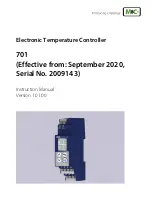
A Word about Position Accuracy
The RC1-H will normally end up within about 2-4 degrees of the desired heading when
using computer control or the Goto button. This depends a lot on the wind load, and
size of your antenna array. If you are working in windy conditions and your ending
azimuth is always exceeds your desired heading, then you may wish to use the COAST
feature to turn off the motor a little early.
Most 3 or 4 element antennas have a large beam width of 50 degrees or more. With
these antennas, being within half the beam width is plenty good enough accuracy.
Menus and Customizing
There are several menus available to customize your RC1-H control box. The menu
options are: Calibrate, Offset, Callsign, Defaults, Coast, Sleep, Northstop, Contrast, and
Brake Delay, (if equipped).
To enter the menu system, press and hold the encoder shaft for a few seconds. Turn
the encoder shaft to change the entry value, and push the shaft (knob) to act as a select
or enter key.
Calibrate
Although you can calibrate the rotator for optimum accuracy, you may find that it is quite
accurate without calibrating. We have found the pots in all rotors tested to be quite
accurate. Just about the only time a pot goes bad is if the rotor system takes a high
voltage surge such as lightning. Most of the time, the only thing you might require is the
Offset feature. This is because your rotor is off the same amount of degrees all the
time. That problem is corrected with Offset feature, not the Calibrate function.
To calibrate your RC1-H, first go into the Defaults menu and wipe out any and all
modifications you have already entered.
If you desire to recalibrate your rotator, the RC1-H does this by the start and end of the
potentiometer, or LEFT stop SOUTH and RIGHT stop. Depending on the model,
RIGHT stop can be 180 for HyGain models.
Else, you must position the rotor to the left stop and right stop, and do NOT concern
yourself with the antenna position right now. If the azimuth heading is not correct, you
can use OFFSET to correct the azimuth. If your pot is off by a lot, for some reason, the
RC1-H will NOT accept the reading. Move the antenna first to the left stop until you see
the antenna will no longer turn left. Do not use the display azimuth to determine if the
antenna is as far left as it will go. Do a left stop calibrate. Similarly, move the rotor to
the right stop and calibrate there. Now you can invoke some OFFSET to correct the
azimuth on the display. Word of caution: it is possible that with a large offset required,
that the hard stops of the rotor come into play. You may feel that the rotor ‘turns the
wrong way’ on an automatic move. But that is possible with a large amount of offset put
in.






























